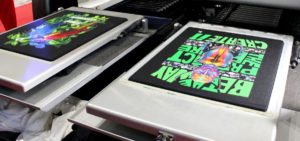
Direct to garment printing (DTG) is a relatively new addition to the garment decoration industry and has been around for about 15 years. Peter Wright, managing director of Amaya Sales UK, reports on how these machines have changed over the years and what you can expect in 2019.
Initially they could not print white, only CMYK. Over the years there have been steady improvements including white ink quality, size, speed and many others.
White ink was the greatest breakthrough but then came along blockage problems mainly because of the white ink formulation. This gave DTG printing a bad name and it stayed in potential users’ minds for quite a while. Over time these issues were solved, and blockages now only happen because of poor maintenance and poor-quality ink.
DTG printing is a method of printing direct on to a garment and works in a similar way to a paper printer. It is normally very easy to use, and the process is also very simple. Good quality printers range from around £7,000 to £800,000 for the high production fully industrial makes. Printers vary in print size from A3, A2+ right up to around 70x100cm. There are also manufacturers producing roll to roll printers that cater for on demand garment manufacture.
To print on to dark garments, you will need to pre-coat the product with a liquid which is normally produced by the ink supplier. This can be sprayed on to the garment with a professional spray gun or you could purchase an auto pre-treater which takes away a lot of the guess work. There is one manufacturer of DTG printers that has pre-treatment built into the system. This can save on time and labour.
Improvements have come in many ways, but I would say that quality, feel and production speed are where we have seen the most.
Quality
Quality has always been pretty good, but some manufacturers have excelled in offering superb quality and in fine detail. This sort of quality is difficult or impossible to achieve with screen printing.
Much of the improvement in quality comes from print head technology but most importantly from the rip software that comes with the printer. These vary from the very basic to high end control.
A good RIP software can control ink amounts and colour as well as setting the design position. It should also help you in organising your production and storing regular run designs.
Feel
As the ink and pre-treatment liquid have improved so as the feel of the finished product. Most DTG printers will now produce a softer feel to the touch which is much more acceptable to the customer.
Speed
This as improved probably by as much as 50% over the last few years. The only drawback is that the cost of the equipment has also increased by around 70%. For this reason, many garment decorators are buying two of the slower ones for about the same price. This modular system gives them more production flexibility and just as much output.
Another factor in the speed of printing is the resolution that you are using. A lower resolution will give you higher speeds but with a lower quality.
Web to print
Some manufacturers offer web to print software and some printers have developed their own package. This is a major advantage for reducing the time from a web site order to the garment being printed.
Normally the order from your customer will create a bar code in your production area, then all the operator as to do is use the bar code reader to scan the code and print. For customers with multiple printers the system can even decide were to send the appropriate order to.
So, with today’s garment buyer wanting a faster and faster delivery, this can now be achieved.
Eco-friendly inks
Another important factor is to make sure your DTG equipment can run on eco-friendly certified inks. Many organisations are demanding this from their suppliers.
Direct to garment printing should now be part of any established garment decoration business. The more options you can offer you customer the more business you should acquire.
So, let’s wait and see what is around the corner in 2019.
 Printwear & Promotion The Total Promotional Package
Printwear & Promotion The Total Promotional Package




